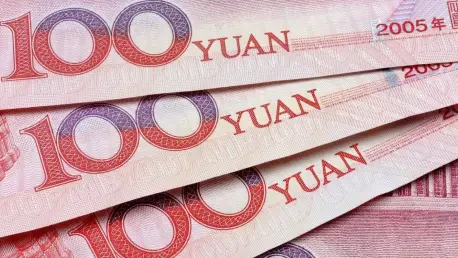China is engaged in deliberate economic maneuvering as it seeks to mitigate the impacts of rising U.S. tariffs on its exports. Recently, the People’s Bank of China (PBOC) implemented a rate cut, reducing the seven-day reverse repurchase rate from 1.5% to 1.4% and lowering the reserve requirement ratio (RRR) by 0.5 percentage points. This move released approximately 1 trillion yuan ($139 billion) into the banking infrastructure, promoting liquidity and cheaper borrowing across key sectors. The necessity and implications of these actions are crucial for understanding China’s approach to sustaining economic resilience through global trade headwinds.
Navigating Economic Shifts and Trade Tensions
In the face of U.S. tariffs, China has shifted focus toward stabilizing internal markets and fostering innovation-led growth. By targeting sectors like technology, real estate, and small businesses, the PBOC aims to counteract the sluggish export growth resulting from hefty tariffs, now at 145% on Chinese imports. The monetary policy adjustments reflect a broader strategy to strengthen China’s economic foundation, preparing for the ripple effects of international negotiations scheduled to take place in Switzerland. As the PBOC carefully orchestrates these shifts, the overarching objective remains clear: solidifying China’s economic prowess and achieving growth targets.
Deep Dive into Market Responses
Sector-Specific Stimulations
China’s targeted approach, characterized by sector-specific monetary interventions, reveals a calculus designed to bolster strategic industries. With zero reserve requirement ratios for auto finance firms and decreased interest rates for lending instruments, the PBOC ensures that these pivotal areas receive enhanced cash flow. The anticipation is that these policies will improve these sectors’ capacity to innovate and manage financial strains, further fueling China’s industrial advancement and technological competitiveness on a global stage.
Strengthening Domestic Markets
Efforts to enhance domestic consumption are integral to China’s multifaceted strategies. By increasing bank quotas for technology funding, policymakers are prompting growth through innovation, reducing dependency on export-driven revenue. This approach underscores the importance of diversifying China’s economic sources of strength and preparing for potential uncertainties. The spotlight on innovation not only aligns with China’s growth aspirations but also positions the nation as a formidable player in the ever-evolving global economy.
Regional Policy Implications
Despite national strategies, regional disparities remain an underlying challenge. Provinces differ significantly in economic output and resource allocation, which can impact policy efficacy unevenly across regions. Addressing these disparities requires tailored interventions, with localized monetary policies offering potential solutions. It is essential to recognize these regional variabilities to ensure balanced growth and prevent bottlenecks in financial resource distribution.
Insights and Strategic Outlook
Future interactions in global trade are set to transform existing dynamics, with technological evolution and regulatory shifts on the horizon. Experts project that these factors will shape the trajectory of China’s economic strategies, potentially necessitating adaptations and recalibrations. Consideration of such elements offers valuable foresight for understanding how China might continue to leverage monetary policies effectively in the face of trade pressures.
Closing Thoughts and Strategic Reflections
China’s recent monetary measures hold significant implications, not only for short-term economic stability but also for long-term growth trajectories. As trade tensions evolve, it is crucial to scrutinize these policies, paving the way for strategic insights that stakeholders can apply. In this complex economic landscape, proactive engagement and adaptation serve as vital elements for capitalizing on opportunities and securing sustained prosperity.









